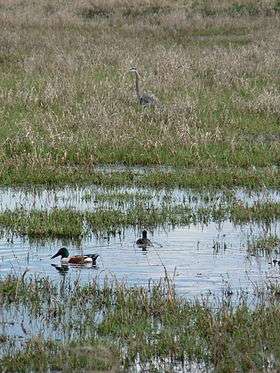Ridgefield National Wildlife Refuge
Ridgefield National Wildlife Refuge is a wildlife preserve, one of the national wildlife refuges operated by the United States Fish and Wildlife Service, located in the westernmost part of Clark County, Washington. The refuge protects more than 5,200 acres (2,100 ha) of marshes, grasslands, and woodlands. The refuge was established (along with 3 other refuges in the Willamette Valley of Oregon) in 1965, in response to a need to establish vital winter habitat for wintering waterfowl with an emphasis on the dusky Canada goose whose nesting areas in Alaska were severely impacted by the violent earthquake of 1964.[5] Ridgefield NWR is part of the Ridgefield National Wildlife Refuge Complex, headquartered in Ridgefield, Washington, which oversees the management of four refuges in the southwestern part of the state: Ridgefield, and three refuges in the Columbia River Gorge: Franz Lake, Pierce, and Steigerwald Lake.[6]
| Ridgefield National Wildlife Refuge | |
|---|---|
IUCN category IV (habitat/species management area) | |
 | |
 Location in Washington state | |
| Location | Clark County, Washington, United States |
| Nearest city | Vancouver, Washington |
| Coordinates | 45°48′15″N 122°45′42″W[1] |
| Area | 5,228.10 acres (21.1574 km2)[2] |
| Established | 1965[3] |
| Visitors | 165,000[4] |
| Governing body | United States Fish and Wildlife Service |
| Website | Ridgefield National Wildlife Refuge |
Refuge units and activities
Preservation of the natural Columbia River floodplain is the management objective of the Carty, 2 mile (3 km) self-guided hiking trail, Roth and Ridgeport Dairy units. The River 'S', 4.2 mile (7 km) auto tour route and 1.2 mile (2 km) seasonal hiking trail, and Bachelor Island units are managed to maximize habitat for waterfowl and other wetland wildlife.
Wildlife
Stately sandhill cranes, shorebirds, and a great variety of songbirds[7] stop at the refuge during spring and fall migrations. Some bird species such as mallards, canada geese, great blue herons, pheasant, ruffed grouse, barn owl, great horned owl, bald eagles, ospreys and red-tailed hawks are year-round residents that nest on the refuge. Black-tailed deer and cougars are the largest mammals on the refuge. Smaller mammal species such as coyote, red fox, raccoon, skunk, porcupine, bobcat, beaver, mink, river otter, muskrat, badger and brush rabbits are occasionally seen.[8]
Quarries
The Carty Unit of the refuge includes seven historic quarries, listed on the National Register of Historic Places as Basalt Cobblestone Quarries District.
See also
- List of National Wildlife Refuges
References
![]()
- "Ridgefield National Wildlife Refuge". Geographic Names Information System. United States Geological Survey.
- "Annual Report of Lands as of September 30, 2013" (PDF). United States Fish and Wildlife Service.
- "About the Refuge". Ridgefield National Wildlife Refuge. U.S. Fish and Wildlife Service.
- "Reidgefield National Wildlife Refuge Profile". U.S. Fish and Wildlife Service.
- "Ridgefield National Wildlife Refuge Brochure" (PDF). U.S. Fish and Wildlife Service. June 2007.
- "Ridgefield National Wildlife Refuge Complex". U.S. Fish and Wildlife Service.
- "Birds of the Ridgefield National Wildlife Refuge". Duane & Shirleen Hymas.
- "Ridgefield National Wildlife Refuge Wildlife Checklist" (PDF). U.S. Fish and Wildlife Service. August 2010.
External links
| Wikimedia Commons has media related to Ridgefield National Wildlife Refuge. |
- Ridgefield National Wildlife Refuge U.S. Fish and Wildlife Service